 Written by Mike Price, OT
Written by Mike Price, OT
For users who are learning to walk, need assistance with walking, or are rehabilitating to regain walking abilities, gait trainers provide support, stability, and postural alignment to facilitate movement while improving function. Gait trainers assist a wide variety of movement-impaired patients, including those suffering from cerebral palsy and spina bifida as well as those rehabilitating their movement following traumatic injuries. Assessing your ability to stand, your strength, sensation, balance, spasticity, and range of motion in your trunk, hips, knees, and ankles determine if a gait trainer is appropriate. Answering the questions in this article will help you decide which gait trainer is best for you. Of course, you should consult with your medical provider if you are unsure of exactly what you need.
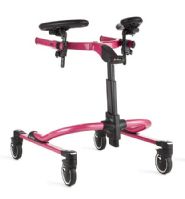 | Rifton X-Large Pacer Gait Trainer View Product |
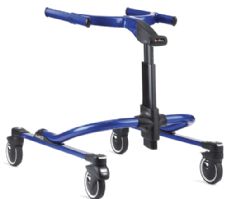 | Rifton Pacer Gait Trainers in Medium and Large View Product |
Anterior gait trainers are what people usually think of when they think of a gait trainer, with the device pushed in front of the user. Also called a "traditional type gait trainer", these are a perfect choice for people who rely heavily on the gait trainer’s support, need to lean to assist in forward movement, and can’t bear their full weight.
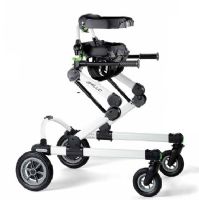 | Ormesa Grillo Posterior Special Needs Gait Trainer View Product |
A posterior gait trainer, also known as a "reverse gait trainer", is positioned behind the user for support. With their hands on each side, the user pushes their weight down through their arms while pulling the gait trainer behind them. These gait trainers are often used by people who started with an anterior model but have progressed in their walking ability. A posterior gait trainer facilitates improved upright standing and walking posture. For some users, a posterior gait trainer helps create a more stable and natural gait pattern.
| Kaye Suspension Gait Trainer Walker View Product |
A suspension gait trainer is also called a "suspension walker" or a "full gait trainer". This design implements a harness system to keep the user upright as they stand and walk. They often have a seat or saddle for resting and can feature a winch to lift the user from a seated to a standing position. For users who can’t bear their weight through their legs, suspension gait trainers provide full support and are often used for post-injury rehabilitation or for learning or relearning how to walk.
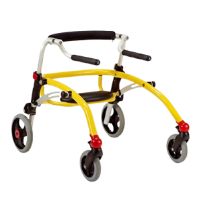 | R82 Crocodile Walker Gait Trainer View Product |
To ensure maximum usability, a gait trainer for home use needs to be able to fit through doorways and spaces around furniture. A lightweight model is preferable, especially if the home has more than one story and the gait trainer will be carried up and down the stairs. The gait trainer you choose for home use should be easily stored, so it’s not creating a tripping hazard by cluttering floors pace when not in use.
.jpg&newwidth=365&maxheight=200) | Mustang Pediatric Anterior/Posterior Gait Trainer for Special Needs Children View Product |
When using a gait trainer for independent mobility in a wide range of settings, versatile features such as swivel wheel locks, large tires, hand brakes, bumpers, chest support, an anti-reverse system, and a fold down seat to rest over long distances provide convenience, comfort, and safety.
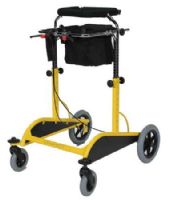 | Ormesa Dynamico Outdoor Gait Trainer View Product |
If you will use a gait trainer to get around outside, the wheels make the difference. Look for models that are specifically made to be used outside. Larger, all-terrain, super durable wheels make navigating off a paved path and onto uneven ground smoother, easier, and safer.
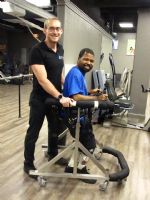 | Second Step Gait Harness System for Practitioners w/ 3 Harness Set (Free USA Shipping, FULLY ASSEMBLED) View Product |
Versatility is a must or devices used by a lot of different people, and gait trainers in hospitals need to accommodate a wide range of patients. Higher weight capacity and multiple harnesses make a gait trainer appropriate in a hospital setting, as do guide bars for medical caregivers to provide assistance.
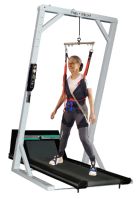 | Single PneuWeight Unweighting Exercise System w/ One FREE Ultima Vest View Product |
A suspension gait trainer positioned over a treadmill provides firm support and allows for full range of motion to promote proper posture and gain. When choosing a gait trainer to use with a treadmill, the most important thing to note is the weight capacity of the gait trainer to ensure it can accommodate anyone who will use it. To manage the treadmill and the gait trainer simultaneously, choose a gait trainer that has simple controls and allows for full freedom of movement while in use.
Arm prompts and platforms dictate where weight bearing is concentrated and can be adjusted as progress is made. When placed horizontal, arm prompts distribute body weight through the shoulders and arms, allowing the legs to move freely. Tilted down, arm prompts extend the arms and prepare the user for moving to walking with handholds. Placing them in front creates a forward leaning position good for users starting gait training. Arm prompt adjustments include height, rotation, angle, forward/backward and lateral proximity to meet posture and position requirements.For users with good upper body control, arm platforms are appropriate when less arm positioning is required.
For users who only need a handhold on their gait trainer, hand loops work best. These handholds can be attached singly or as a pair and are angle and height adjustable.
Handlebars provide a comfortable palmar grasp. They attach quickly and the height and rotation are easily adjusted for optimal support and steering.
A chest prompt is a padded support designed to securely hold the user’s torso at the appropriate angle while gait training. Chest prompt adjustments can be made to the width and the tilt angle for the best support and alignment.
A multi-position saddle has many adjustable options to allow for exact pelvic positioning to accommodate a client’s posture.
A seat is especially useful for people who spend long periods standing in their gait trainer. Whether taking a breather during a therapy session or taking a short rest during a walk in the park, a convenient fold-down seat available allows people to easily stop for brief breaks while using the gait trainer.
A flexible weight bearing pelvic support benefits patients who have good hip stability and control, or who use it as a progression from a more rigid multi position saddle. A pelvic support is softer than the hip positioner and is used by patients who need less hip abduction. Similar to a sling seat, this accessory assists with weight bearing while still allowing for freedom of movement.
Good positioning is a big component of gait training, and a hip positioner is a semi-rigid weight-bearing prompt. It assists the user by facilitating natural pelvic movement and weight shifting on legs while providing additional leg abduction.
 | Rifton Pacer Gait Trainers in Medium and Large View Product |
Thigh prompts are height adjustable in the medial and lateral positions,and assist with leg alignment and adduction control. They keep the user from turning with the frame of the gait trainer. They also swing with the patient’s stride to prevent leg scissoring.
Ankle prompts help control foot positioning and can prevent scissoring, setting the amount of foot separation, length of stride, and proper stride placement.
Knee supports help keep the patient in the correct gait pattern. During therapy, with the knee correctly placed, the therapist can focus on other priorities like control of the hips and torso.
Foot supports can reverse mild to moderate plantarflexion/inversion/eversion ankle contracture. They can assist with weight bearing and gait training.
 | Rifton X-Large Pacer Gait Trainer View Product |
If a gait trainer is going to be part of your life, there’s no reason not to express yourself through your choice of frame color. If you’re going to be spending a lot of time with a device, it might as well be aesthetically pleasing!
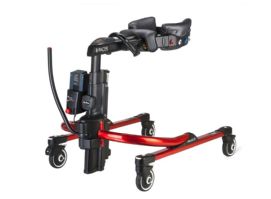 | Rifton E-Pacer Lift and Gait Trainer View Product |
Gait training often happens along a progression. A gait trainer with Bluetooth allows for caregivers to track a user’s weight-bearing progress over time to measure success and make appropriate changes to a treatment plan. A cheaper alternative is to purchase an odometer, which will only record the number of steps.
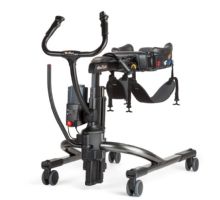 | Rifton TRAM Multifunctional Gait Trainer View Product |
A multi-purpose design is used for sit-to-stand and seated transfers, in addition to gait training. This versatility allows for caregiver and patient safety and convenience, assists with getting users in and out of chairs and wheelchairs, and an adjustable width base makes it easy to get through doorways.
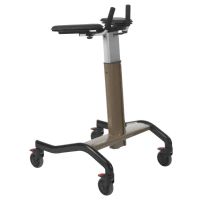 | Dolomite Step-Up Gait Trainer View Product |
Removable hand brakes attach to the arm prompts and deliver running and parking functions with an easy-to-use lever-action control.
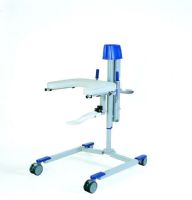 | Hi-Lo Lift Walker by ArjoHuntleigh View Product |
Electric models eliminate any caregiver strain when raising and lowering a patient. Hand controls keep caregivers close and available while monitoring a patient’s up and down movement.
The correct frame size is imperative for optimal performance when choosing a gait trainer. Some of these devices designed specifically for children are adjustable, so they can accommodate your child’s growth and have a long service life. Typical measurements that determine frame size include axilla/armpit to floor height, wrist to floor height, groin to floor height, chest width, hip/seat width elbow to floor height, and the height and weight of the user.
Standard lifting capacity for most gait trainers is 350 pounds. When using a harness or sling with a gait trainer, the sling’s weight capacity must be equal or greater to that of the gait trainer. Rehabmart carries bariatric models with higher weight capacity, including the Up n' Go 200 Bariatric Gait Trainer,
Knowing where the gait trainer will be used and ensuring it will be able to fit through doorways to maximize the opportunity for mobility and can influence the purchasing decision. Most will fit through a 32-inch doorway, as the clear width of a door opening must be a minimum of 32 inches according to ADA standards.
Although not all gait trainers have adjustable bases, the ones that can be adjusted to a wider width base allow the user to get closer to a wheelchair for easier wheelchair transfers.
A: No, although they appear similar, they are designed to assist different users. A gait trainer offers more balance assistance and weight-bearing support. Walkers are usually used by people who can bear their weight fully through their legs. Gait trainers are used by people who cannot fully bear their weight through their legs.
A: Private insurance insurance will likely cover adaptive equipment such as gait trainers. Usually combined with walkers under Medicare guidelines, gait trainers are considered durable medical equipment and when prescribed as medically necessary by a physician, they are eligible for coverage under Medicare Part B.
We cannot guarantee your insurance coverage, and you will need to speak with your doctor regarding coverage. And please note that Rehabmart does not accept insurance.
A: A gait trainer is an assistive device similar to a walker, and they are sometimes confused with walkers. A gait trainer, however, has enough support to bear the weight of a user who can’t stand or walk without assistance, while a walker is more for balance than weight bearing. Gait trainers have different levels of support to benefit users with varying levels of muscle tone, and many models can be modified to adjust the level of support as therapy progresses.
A: Gait trainers are used by children and adults who can’t consistently bear their full weight through their legs. They help build postural stability and strength, improve alternating and reciprocal leg movements for stepping, and enhance endurance. They’re frequently used following an injury or surgery for walking rehab, for learning how to walk, and by people living with medical conditions like cerebral palsy, spina bifida, and other long-term issues that impair mobility,
A: Rifton’s line of adult gait trainers, gait trainer walkers, and body weight supported treadmills for gait training are available at Rehabmart.com. Shop Rifton gait trainers for adults and shop Rifton Gait Trainers for children.
A: Gait trainers for adults safely support users in an upright position, allowing them to practice walking independently with the help of a physical therapist. The goal is to strengthen muscles and joints, improve posture, build endurance, increase balance, and retrain legs to develop muscle memory.
A: The most typical measurements needed for a gait trainer:
A: Dynamic pelvic supports are less bulky between the legs and are softer, more flexible alternatives to hip positioners. They provide weight-bearing support as needed and allow for natural hip rotation and 360-degree controlled steering.
Gait trainers provide the alignment, stability, and support needed to facilitate movement while improving function while gaining or regaining the ability to walk. They are used by people with cerebral palsy and spina bifida and those rehabilitating after injuries.
Gait trainers come in anterior, posterior, and suspension designs, each with many customizable features such as supports, convenient accessories, and indoor- and outdoor-specific frames and wheels.
Thank you for your time investigating how to choose the best gait trainer for your situation. Visit
Caregiver University for more articles to help you make an informed purchasing decision.

Co-Founder of Rehabmart and an Occupational Therapist since 1993. Mike has spent his professional career working in multiple areas of Occupational Therapy, including pediatrics, geriatrics, hand therapy, ergonomics and inpatient / outpatient rehabilitation. Mike enjoys writing articles that help people solve complex therapeutic problems and make better product choices.
)
